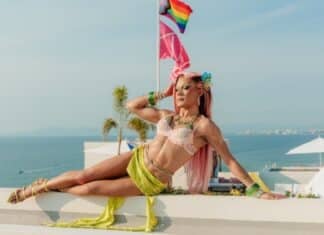Esta publicación también está disponible en: English Español
Por Jason Villemez – El30 de junio en Nueva York, tras una semana de abundantes celebraciones, concentraciones y atención mediática mundial, un grupo de veteranos activistas LGBTQ marchó por la Quinta Avenida portando una pancarta en la que se podía leer: «Frente de Liberación Gay: Los primeros en marchar». Sus edades oscilaban entre finales de los 60 y mediados de los 80 años. Llevaban camisetas a juego con su lema. Algunos llevaban chapas con fotos de amigos desaparecidos hace tiempo. Y mientras caminaban por el centro de la ciudad hacia Christopher Street y el Stonewall, los espectadores los recibieron con un atronador aplauso, un agradecimiento por la labor que iniciaron hace cincuenta años, labor que dio lugar a la comunidad LGBTQ que conocemos hoy.
«Ha sido el punto culminante de mi larga vida», dijo Ellen Broidy. «¡Me hizo especial ilusión poder compartirlo con mi cónyuge desde hace 40 años!». Broidy fue uno de los creadores del primer desfile del orgullo, llamado Christopher Street Liberation Day March, que tuvo lugar en junio de 1970 y contó con varios miles de participantes.
Al igual que Broidy, todos los integrantes del contingente del Frente de Liberación Gay de 2019 desempeñaron un papel en el movimiento que comenzó con una chispa y prendió en todo el mundo.
GLF fue Gran Mariscal del desfile, título que compartió con Monica Helms, creadora de la bandera transgénero, Phyll Opoku-Gyimah, cofundadora del Orgullo Negro del Reino Unido, The Trevor Project, y el reparto de la serie de televisión «Pose», de FX. Fueron de los primeros de los 695 contingentes que desfilaron en el mayor desfile del orgullo de la historia de Estados Unidos. Durante doce horas, los espectadores vieron desfilar por la ciudad a bandas de música, políticos, grandes bancos, grupos religiosos, agencias de turismo, marcas de cuidado de la piel, conglomerados de golosinas, clubes de moteros homosexuales, empresas sanitarias, grupos de derechos civiles y todo tipo de organizaciones en honor a la rebelión -y a las personas- que puso en marcha todo el movimiento por la igualdad. Todos caminaron, en cierto sentido, para honrar a grupos como el Frente de Liberación Gay.
El GLF se creó en las semanas posteriores a la Rebelión de Stonewall como medio de aprovechar el nuevo empoderamiento y la visibilidad que el acontecimiento había suscitado. Los miembros se reunían en iglesias y en el centro Alternate U. de West14th Street. Organizaron marchas, redactaron boletines y organizaron bailes para recaudar fondos, todo ello mientras intentaban comprender, hacer realidad, las posibilidades de lo que podría ser una comunidad gay. Procedían de todas las partes del país y tenían puntos de vista diferentes, lo que a veces provocaba tensiones en sus reuniones de consenso, pero, en general, el grupo era una familia. Muchos vivían juntos y se ayudaban emocional y económicamente. Comprendieron la fuerza de la solidaridad. Querían igualdad de derechos, respeto básico, ser tratados con decencia.
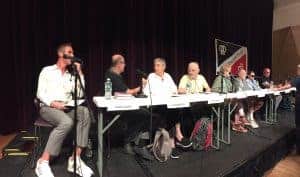
También querían esas cosas para los demás. Apoyaron y marcharon con los Panteras Negras, al igual que con los Young Lords y los movimientos feminista y antibelicista. La mayoría de ellos alcanzaron la mayoría de edad en la época de los derechos civiles y trajeron consigo las lecciones aprendidas tanto de los pacifistas como de los radicales. Comprendieron, como se ha demostrado a lo largo de la historia, que eran más grandes juntos que separados.
Aunque la lucha por la igualdad era un asunto serio, también era alegre. Se hicieron amistades para toda la vida. Se celebraban cumpleaños, se asistía a maratones de cine y se conversaba hasta altas horas de la noche en los umbrales de los brownstones de Christopher Street. Eran, como es de imaginar, una reminiscencia de cualquier grupo de jóvenes y jóvenes de corazón. Improvisaban música popular de la época, como los Beatles y las Supremes. Se apoyaban mutuamente en su arte. Se cuidaban mutuamente. Y, como los testarudos miembros de las bandas que idolatraban, al final tomaron caminos separados.
El hecho de que la GLF de Nueva York se disolviera relativamente pronto en la lucha por los derechos civiles de los homosexuales significó que su historia se cedió en gran medida a las organizaciones menos radicales y más políticamente correctas que surgieron después. Pero aunque el grupo cesó su actividad en 1973, sus miembros siguieron adelante. Michael Lavery fue cofundador de Lambda Legal. Perry Brass fue uno de los fundadores de la Clínica Gay Men’s Health Project. Rita Mae Brown y Barbara Love fueron miembros originales de la Amenaza Lavanda. El Frente de Liberación Gay fue en parte un laboratorio de ideas, en parte una universidad y en parte un centro comunitario que fomentó una familia de personas con ideas afines que decidieron cambiar el mundo.
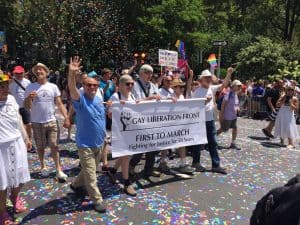
Durante todo el mes de junio se recordó eso y mucho más. A todas horas, los miembros del GLF aparecían en la televisión, en actos y en la prensa para contar la historia de Stonewall y los años posteriores.
«Creo que este verano ha sido sólo el comienzo de la gente que ha empezado a analizar seriamente nuestra historia», declaró Mark Segal, uno de los primeros miembros de GLF y editor del Philadelphia Gay News. «Los principales medios de comunicación querían saber más sobre la conexión entre Stonewall y el primer orgullo gay. Hicimos que la gente se diera cuenta de que el primer año después de los disturbios el GLF realineó a toda la comunidad, la hizo interseccional y la diversificó. Eso es lo que hicimos entonces, y eso es lo que espero que la gente se lleve de todos los medios de comunicación y de los actos de Stonewall 50».
El jueves anterior al desfile, los miembros de GLF celebraron una mesa redonda en el Centro Comunitario LGBT de la calle13, con el aforo completo. El acto contrastaba con los conciertos patrocinados por empresas en el muelle 97 (apodado «Pride Island») o la ostentosa ceremonia inaugural en el Barclay Center de Brooklyn. A primera hora de la tarde, ancianos, jóvenes, familias y un equipo de rodaje abarrotaron el anodino auditoriode la tercera planta, el mismo espacio donde se han celebrado los funerales de compañeros pioneros, muchos de los cuales eran miembros del GLF.
Los panelistas hablaron de su trabajo con inmigrantes homosexuales, de su trato con la policía y de sus experiencias tras Stonewall. Hablaron del incidente del Snake Pit de 1970, en el que la policía hizo una redada en el bar y una persona, temiendo ser deportada, saltó por una ventana y fue empalada en una valla. Estas fueron las historias reales de Stonewall directamente de aquellos que las vivieron. Durante noventa minutos, dieron una lección de historia inigualable.
«Fue estupendo que hubiera tanta diversidad de edades entre el público», dijo John Knoebel, miembro de GLF, que contó a la multitud su encuentro con el líder de los Panteras Negras, Huey Newton. «Había gente que había estado con nosotros hace cincuenta años, pero también muchos jóvenes que parecían estar absorbiéndolo como una esponja. Hay un segmento de la juventud LGBTQ de hoy que realmente quiere aprender su historia y siente que no la reciben en sus escuelas».
Transmitir la historia de Stonewall fue una parte importante de las celebraciones del 50 aniversario. Uno de los actos menos conocidos que tuvieron lugar durante la semana del Orgullo fue un encuentro intergeneracional entre miembros de GLF y estudiantes de todo el país.
Los dos grupos se reunieron en un aula y compartieron historias sobre sus vidas. Las adolescentes conocieron el grupo Radicalesbians; las pioneras aprendieron siglas como TERF (feminista radical transexcluyente). Los adolescentes preguntaron a los pioneros sobre héroes como Marsha P. Johnson y Sylvia Rivera, sobre cómo era vivir en una época que sólo conocían de segunda mano. Los pioneros estaban deseosos de saber cómo se definen hoy los jóvenes queer.
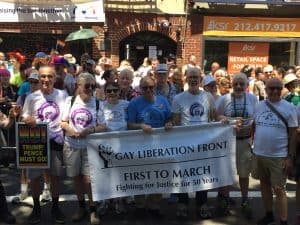
Ambas partes salieron de la discusión con respeto mutuo y aprecio por la historia que aún se está haciendo. Algunos miembros de GLF estuvieron en la primera noche de disturbios, el 28 de junio de 1969; otros se unieron a la segunda, tercera y cuarta noches. Pero es el trabajo que hicieron como grupo en las semanas y meses siguientes, celebrando protestas y bailes, proporcionando alertas médicas y asesoramiento jurídico, repartiendo folletos por la calle, lo que mantuvo el impulso de Stonewall y garantizó que no sería otra protesta pasajera, otra noche de furia que se calmó por la mañana.
Al final, el GLF se disolvió porque el grupo se dividió en facciones con prioridades distintas. Cincuenta años después, esa mentalidad de «forja tu propio camino» volvió a presentarse. El Día del Orgullo, algunos miembros optaron por renunciar a ser Grandes Mariscales en el desfile oficial (organizado por la organización sin ánimo de lucro Heritage of Pride) y participar en la marcha alternativa Queer Liberation March, que utilizó el mismo recorrido que la primera marcha del orgullo, empezando en el Stonewall Inn y terminando en Central Park.
La marcha, creada por la Reclaim Pride Coalition como un esfuerzo popular sin carrozas corporativas ni policía, culminó con una concentración que recordaba a la de los años setenta, con oradores como Larry Kramer, Masha Gessen y Martha Shelley.
Shelley, uno de los fundadores del GLF, se dirigió a una multitud igualmente enérgica hace cincuenta años, en la culminación de una marcha de protesta en julio de 1969. Ella y el activista Marty Robinson se colocaron en la fuente de agua de Christopher Park, frente al Stonewall, y hablaron a 400 personas «que ese día habían demostrado el valor de mostrarse abiertamente homosexuales a la luz del sol en lugar de ocultar sus rostros».
En 2019, la multitud de 45.000 personas congregadas en Central Park superó con creces a los 400 de Christopher Park, un testimonio del cambio cultural y político impulsado por los primeros activistas. Shelley compartió con ellos algunas de las estrategias de éxito que el GLF utilizó para conseguir esos avances.
«Sólo esperaba que lo que tenía que decir llegara a algunos de ellos, que lo recordaran y actuaran cuando llegaran a casa, para continuar la lucha y establecer alianzas con otros grupos progresistas».
Ciudades de todo el mundo conmemoraron el 50 aniversario de los disturbios de Stonewall. Berlín, Taipei, Tel Aviv. Pero es apropiado que la mayor se produjera en Nueva York, donde comenzó. Cinco millones de visitantes abarrotaron la ciudad. Durante toda la semana, la gente peregrinó al Stonewall, ahora monumento histórico nacional y objeto de excursiones escolares, con la esperanza de contagiarse del brío que recorrió el aire hace tanto tiempo, de sentir la alegría que se filtró en las venas de quienes tomaron partido. El domingo, cuando comenzó el desfile, la multitud -y las personas a las que vitoreaban- ya sentían la gravedad del momento.
Mark Horn recorrió la ruta con sus compañeros del Frente de Liberación Gay, sosteniendo un lado de la pancarta como ha hecho en muchos desfiles del orgullo neoyorquino. Se maravilló de lo mucho que ha crecido la participación desde la primera marcha en 1970. Participar en aquellos primeros desfiles del orgullo significó ver muchas caras conocidas, personas que entonces tuvieron el valor de «salir del armario y salir a la calle». Hoy en día, con millones de personas desfilando y entre la multitud, es más difícil distinguir a la gente que uno reconoce. Esto es especialmente cierto para los primeros activistas como Horn, que soportaron la muerte de muchos en los años 80 y 90.
«Mientras caminaba con mis amigos de GLF, me sentía feliz y triste a la vez. Sentí la pérdida de tantos amigos y amantes a causa de la crisis del VIH. Pero me animó la multitud. Durante todo el recorrido, cuando la gente veía nuestra pancarta, los aplausos se hacían más fuertes y se oía a la gente gritar ‘¡Gracias!’ una y otra vez. Marché con un corazón roto que se llenó de la gratitud y el amor de la multitud».
Los miembros del Frente de Liberación Gay, y todos los activistas de esa época, están envejeciendo. Su número está disminuyendo. Es un hecho inevitable. Jerry Hoose, que organizó la reunión de GLF con motivo del 40 aniversario de Stonewall, falleció en 2015. Lo mismo ocurrió con Sidney Abbott, que colaboró con la Organización Nacional de Mujeres para crear el Grupo de Trabajo NOW sobre Sexualidad y Lesbianismo. Angela Douglas, Arthur Evans, Bertha Harris, todos se han ido.
La capacidad de pintar un cuadro completo y contextual de lo que fue Stonewall, lo que fue GLF y lo que fue el movimiento, está disminuyendo rápidamente. Este año del 50 aniversario, con todas las historias relatadas y todas las personas homenajeadas, mostró una franja increíblemente amplia, aunque en última instancia incompleta, de esa historia.
Casi al final del desfile, cuando el contingente del GLF se acercó al Stonewall, se detuvo para hacerse una foto frente al lugar donde empezó todo, el lugar donde tomaron la rabia de un momento de «basta ya» y cambiaron el mundo. La policía trató de ayudarles, ordenándoles que siguieran andando. Al fin y al cabo, aún quedaban muchos grupos por desfilar. Pero se mantuvieron firmes y lo absorbieron todo. Y lo que dijeron a los agentes recuerda aquella noche de junio de 1969: Este es nuestro lugar, y no nos vamos a ir a ninguna parte.
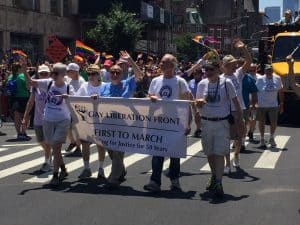
Esta publicación también está disponible en: English Español












